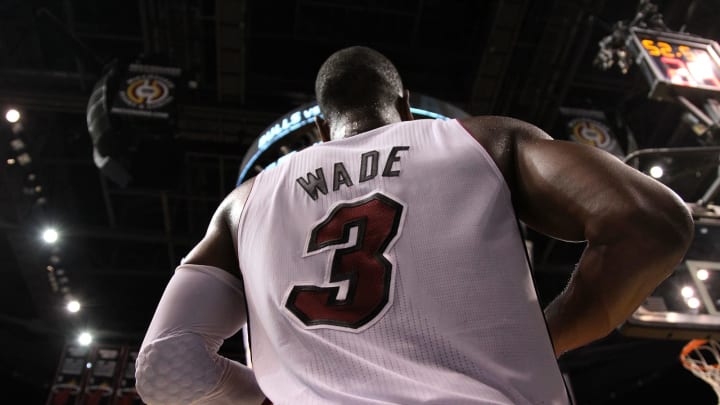It’s going to be weird.
On October 6, the Golden State Warriors will play their first preseason game, a home matchup against the Sacramento Kings. At that point we will have our first extended look at Kevin Durant playing basketball in a Golden State Warriors jersey. Two days later, the Chicago Bulls will play their first preseason game, against the Indiana Pacers, and we will have our first chance to see Dwyane Wade sweating through an iconic red Bulls kit.
Through the power of sloppy photoshops, you’ve probably already seen both players in their new uniforms. Seeing them on the court — moving, cutting, bent over, breathing hard with hands tugging the bottom of unfamiliar shorts — that will be something different. Whoever you root for, wherever you stand on their offseason decisions and their teams, old and new, the visual will give your brain a little something extra to work through. The same is true for Al Horford in the Boston Celtics green and white, or Serge Ibaka in the Orlando Magic’s pinstripes.
Rooting for laundry is, at some level, an essential part of the fan experience but it’s easy to forget how much logos, color schemes, and typography can come to define the way we think about certain players.
*****
Engaging with sports is, on some level, an exercise in building myths and stories. Narratives have long been a tool for understanding the world, a kind of emotional shorthand for phenomenon too complex to fully interact with in our daily lives. The result is that metaphoric values and mythic qualities get piled onto actions, players, and teams. This is how certain basketball plays end up carrying moral weight — three-pointers=righteous, mid-range jumpers=evil — and how teams end up with identities that persist long after the players who helped construct them have moved on.
Team identity becomes indelibly bound with the uniforms they wear. Celtic green is the garb of the working-class hero, Lakers’ purple and gold is the costume of basketball’s 1%. When those associations are strongest, a shirt can define how we think about a player as much as the aesthetics of their jump shot or the way they dribble. This is what justifies an organization trying to erase a chaotic history of bad luck or organizational ineptitude with a new logo and three new complementary colors. The power of branding, and rebranding, derives directly from the amorphous values and characteristics that fans accept as representative of each team. Basketball can exist without these brightly colored trappings; it can be played shirts vs. skins. But Michael Jordan never looked right in a plain white Hanes t-shirt, let alone a cartoonish Washington Wizards jersey.
In a Miami Heat uniform, Dwyane Wade’s greatness is still tangible. The white, red, and black, is an aesthetic time capsule, a little vaseline on the lens for those nights when his knees are aching and the mid-range jumpers aren’t falling. In a Bulls uniform, Wade is visually removed from the past. It’s just a jersey but it’s still one more barrier between our memories and the present unfolding on our television sets.
In a Miami Heat uniform, Dwyane Wade is still an all-time great fighting off the ravages of time. In a Bulls uniform, he may just be one more eroded veteran fumbling with his legacy and legs that don’t respond the way they used to. To be clear, moving to Chicago doesn’t actually change Wade the player beyond the passage of these three summer months of alternating rest and workouts. But he’ll look different and our neurons and gray matter will passionately argue that, as such, he is different.
To wit, Kevin Durant will be the same player next year. He might shoot a little less, pass a little more. Chances are he will win a few more games than he did last season and, if things go according to plan, he’ll earn himself a nice shiny ring at the end of the season. But he will bring the same fundamental skill set to bear in solving basketball problems. All that he is off the court, the human being that fans may fallaciously think they thoroughly grok through mid-game facial expressions and post-game quotations, will likely be unchanged as well.
What has changed is the story that the sports world has been carefully building around him. He chose to leave the Oklahoma City Thunder for the Warriors. He chose the bigger market, the better team, the easier path — those and dozens of other overly simplified critiques will be used to paint him as a fundamentally different character, pushing his story in a darker direction. This process began when he made his decision and it has been slowly ramping up all summer. When he takes the court for the first time in a Warriors jersey, literally shedding the figurative identity we’ve built around him in a Thunder uniform, things will get visceral.
It’s all digital hand-wringing and mud-slinging until he actually puts on the uniform, one more reminder that NBA players don’t actually care much for the fictional works we’ve cast them in.
These dudes are working on their own stories.
The same old faces in new places, new costumes for familiar characters, it’s jarring experience at the beginning of every season. It’s also an entirely one-sided experience. Wearing a Warriors jersey doesn’t make Kevin Durant anything. It’s unfamiliar and our minds fill in the gaps, reconciling an idea that has suddenly become unstable.
Laundry has power — just ask the guys burning Durant and LeBron jerseys — but it’s the power of illusion. Players change uniforms but rarely themselves, we can’t help but rewrite the stories around them.
